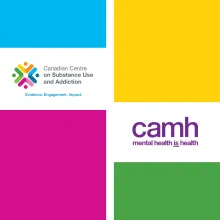Collaborating to Improve Long-term Well-being

The connection between housing insecurity and substance use health is well known. Supporting people’s needs with whole-of-health approaches increases their chances of long-term well-being. This includes considering mental, physical, social and substance use health (SUH) factors.
Recognizing this, the Centre for Addiction and Mental Health (CAMH) connected with us to collaborate on ways to better incorporate SUH into Housing First practices.
What is Housing First?
Housing First is an approach that provides housing as the first step, in combination with supportive services, to people who are homeless and have mental health issues. It is based on the idea that the first and most primary need for people is stable shelter, and that other issues a person has can be addressed once they have a place to live.
Housing First is recovery-oriented and client choice is at the centre. Unlike traditional emergency shelters or transitional housing, it provides immediate access to permanent housing.
Originating in New York City (Pathways to Housing), it is an evaluated approach that provides immediate access to both permanent, independent housing through rent subsidies and mental health supports such as Assertive Community Treatment or Intensive Case Management.
Housing First is guided by three principles:
Heading
Free choice
Professionals help participants decide where they want to live. Research shows that 84 per cent of people who are homeless want to live independently in regular housing like everyone else. Rent supplements give people the means to access this kind of housing.
Heading
Recovery
Recovery is a treatment objective that refers to a participant’s journey of growth and self-improvement to achieving life satisfaction. Pursuing one’s hopes and goals, finding meaning and purpose, while managing one’s mental illness and/or addictions, are all part of recovery.
Heading
Community Integration
People with mental illness who are homeless often experience segregation, exclusion and stigma. The Housing First model separates housing from support, so people live independently in apartments in different areas of the community. Staff are not present onsite, nor are participants congregated in one building with other participants. This way reduces stigma and does not single out people with mental illness.
Heading
Integrating Substance Use Health into Housing First Principles
To develop strong solutions for better incorporating substance use health into Housing First practices, CAMH and CCSA are focusing on three core components:
Heading
Funding & Sustainability
- Secure funding to hire/retain qualified staff to provide services
- Secure, consistent, coordinated funding to continue to hire and qualified staff for the long term
Heading
Policy & Structural Changes
- Develop and standardize best practices for substance use health in Housing First
- Foster collaborative and supportive relationships with landlords
- Create guidelines to balance the well-being of individuals with different substance use preferences
Heading
Enhanced Service Delivery
- Provide people with access to interdisciplinary care teams and coordinated services
- Provide integrated care for concurrent mental health and substance use health concerns
- Provide people with access to the full spectrum of SUH services and supports
Heading
Guidance, Tools and Resources
CCSA produces research-based publications, tools, and resources to support evidence-based decision-making on substance use health issues. Select your area of interest from the categories below to learn more:
Heading
Substances
CCSA produces a variety of substance use- and addiction-related publications for researchers, policy makers and health service providers. We provide guidance to decision makers through harnessing the power of research, collecting and organizing knowledge, and bringing together diverse perspectives.
Heading
Health and Public Safety
CCSA conducts research, develops tools and resources, and produces targeted materials to support evidence-based decisions and public policy. Review our key resources on health and public safety in relation to substance use health and addiction issues.
Heading
People and Communities
CCSA is dedicated to the health and well-being of individuals and communities, focusing on the impact of substance use across the lifespan, the perspectives of people with lived experience, and the roles of stigma, sex and gender, and educators in substance use health.

